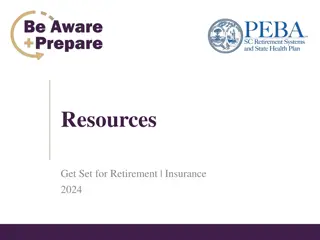Understanding Life Insurance: Definition, Benefits, and Importance
Life insurance is a contract providing financial protection in case of death. It serves various needs like income replacement, savings, investments, retirement planning, and risk transfer. Purchasing the right policy from registered insurers is crucial for tailored benefits.
Download Presentation

Please find below an Image/Link to download the presentation.
The content on the website is provided AS IS for your information and personal use only. It may not be sold, licensed, or shared on other websites without obtaining consent from the author. Download presentation by click this link. If you encounter any issues during the download, it is possible that the publisher has removed the file from their server.
E N D
Presentation Transcript
Life Insurance Definition, Need and Benefits
Life Insurance Definition, Need and Benefits Life insurance is a contract between two parties whereby one party agrees to pay to the other party, a certain amount of money as premium to make good the loss of life arising out of an uncertain event of death in which the insured has interest.
The Products There are a variety of life insurance products to suit to the needs of various categories of people children, youth, women, middle-aged persons, old people; and also rural people,etc. Life insurance products could be purchased from registered life insurers notified by the IRDA. Insurers appoint insurance agents to sell their products. Public who are interested to buy life insurance products should receive proper advice from insurance agents/insurer so that a right product could be chosen to suit particular financial needs.
Need for the Life Insurance Insurance was realized what a useful tool it was in a number of situations, including: 1. Temporary needs threats: The original purpose of Life Insurance remains an important element, namely providing for replacement of income on death etc. 2. Regular saving: Providing one s family and oneself, as a medium to long term exercise (through a series of regular payment of premiums). This has been become more relevant in recent times as people seek financial independence from their family. 3. Investment: Put simply, the building up of saving while safeguarding it from ravages of inflation. Unlike regular saving products are traditionally lump is investments, where the individual makes are one time payment.
4. Retirement: Provision for ones on later years has become increasingly necessary. Especially in charging culture abs social environment, one can buy a suitable insurance policy periodical payments on one s old age. 5. Social security: Insurance also provide some social security that insured expects in future such as a particular sum of money for the education and wedding of children. One may like to buy an insurance policy for a specific sum to meet such a lump sum commitment. which will provide
6. Transfer of risk: Payment of insurance premium results in an outflow of disposable income. Insurance may solve future cash inflow problems that will occur during ones lifespan. Therefore, provide a cover and transfer the risk. 7. Diffusion of risk: The amount and mode of payment spend on insurance is as per the option picked by one according to his own choice. Therefore one can park funds according to their choice of risk and return.
8. Profitable opportunity: Our present age is a critical factor in deciding the quantum of insurance that one can afford. The rates of premium go up with the advancing age of the life assured. 9. Tax savings: If people have an option of risk coverage with guaranteed return and tax saving they will surely prefer it. Generally policyholders take into account the tax benefit under Section 80C.
The Five Simple Rules for Life Insurance 1. Income rule: The most basic rule of thumb is provided by the income rule which holds that individual insurance cover should be at least around eight to ten times one s gross annual income. For example, a person earning a gross annual income of 1 lakh should have about 8 to 10 lakh in life insurance cover. 2. Income plus expenses rule: This rule suggests that an individual needs insurance equal to five times of his gross annual income, plus the total of basic expenses like housing or car loans, personal debt, childs education, etc. 3. Premiums as percentage of income: By this rule, payment of insurance premium depends on disposable income. In other words, one should decide the quantum of insurance after meeting the regular outgo from salary.
4. Capital fund rule: This rule suggests that if one need 1 lakh per annum for his family needs and assuming one does not have any other income-generating assets, one may like to create a capital fund of 12.5 lakh which can yield 1 lakh annual income at the rate of 8 percent per annum, one may therefore buy a life insurance policy of 12.5 lakh. 5. Family needs approach: This rule holds that one purchases enough life insurance to enable his family to meet various expenses in the event of key earning person s death.
Benefits of Life Insurance 1. It is superior to traditional saving machine. In the event ultimately death, of say, the main earner in the family, the policy will pay out guaranteed sum assured, which is likely to be significantly more then the total premiums paid.
2. It encourages saving and forces thrift Once an insurance contract has been entered into, the insured has an obligation to continue paying premiums, until the end of the term of policy, otherwise the policy will lapse. In other words, it becomes compulsory for the insure to save regularly and spend wisely. In contrast saving held in a deposit account can be accessed or stop easily.
3. It provides easy settlement and protection against creditors Once a person appointed for receiving the benefits or a transfer of rights is made (assignments), a claim under the life insurance contracts can be settled easily.
4. It can be enchased and facilities borrowing. Sum contracts may allow the policy can be surrendered for a cash amount, if policy holder is not in a position to pay the premium. A loan, against certain policy, can be taken for a temporary period to tide over the difficulty.
5. Tax relief: The policy holder obtains income tax rebates by paying the insurance specified from of saving which enjoys a tax rebate u/s 88 of the income tax act. Include Life Insurance premiums and contribution to a recognized PF etc. premium. The
Common definitions Risk: Risk is a term that we use to refer to the chance of suffering a loss as a result of uncertain events like fire, flood, and robbery Speculative Risk: Risks judgment based on speculation. Change in govt. policy, fashion etc. Pure Risk: Risks where the chance of loss is predictable Property Risk: Related to Loss of property Personnel Risk: Related to life or health of the individuals relating to business
Insurance Penetration Penetration rate indicates the level of development of insurance sector in a country. Penetration rate is measured as the ratio of premium underwritten in a particular year to the GDP. Insurance density Insurance density is defined as the ratio of premium underwritten in a given year to the total population (measured in US$ for convenience comparison), the Survey said. Financial Risk: Related to financial transactions of the business Marketing Risk: Risks associated with marketing of goods, price reductions or sales related risks of international
Peril: Peril is the cause of loss Some examples of peril are fire, flood, earthquake, lightning and landslide Hazard: The condition resulting in increasing the chances of loss is called as hazard Insurer: The party who agrees to pay money to another party on the happening of a stated contingency, in simple words, the insurance company Policy: the document or the physical evidence of insurance contract Premium: The amount paid to the insurer to secure the payment of the sum assured on the happening of the event insured against. Subrogation Subrogation means to take place of another.
Qualification for issuing Insurance Agents Licence to an individual. The qualifications necessary before a license can be given are that the person be at least 18 years old. He have passed at least the 12th standard or equivalent examination, if he is to be appointed in a place with a population of 5000 or more, or 10th standard otherwise have undergone practical training for at least 100 hours in life or general insurance business, as the case may be, from an institution, approved and notified by the IRDA. In the case of a person wanting to become composite insurance agent, the applicant should have completed at least 150 hours practical training in life and general insurance business, which may be spread over six to eight weeks. have passed the pre-recruitment examination conducted by the Insurance Institute of India or any other examination body recognized by the IRDA.
Why insurance is not a gambling? Ans-Gambling is illegal which gives gain to one party and losses to other while insurance is a valid contract to indemnity against losses so insurance is not a gambling.
Insurance is an co-operative device. Ans- In insurance, there is a common fund which is created by the contributions of a large number of people. When the loss event happen with any one ,he is compensated from the fund.So Insurance is an co-operative device.
Define the principle of utmost good faith. Ans The principle of utmost good faith means to disclose all the important facts and information by the person getting insured and insurer to each other.
Define the principle of the Doctrine of cause proxima. Ans The principle of the Doctrine of cause proxima says that if there are many reasons to cause damage to the insured subject then,the closest cause is to be considered rather than those cause which are remote, immaterial or secondary than primary.
Case Studies 1 Mr. Shah and his five closest friends have decided to insure that each memberof their exclusive group is assured of a bright future. Mr. Shah is thetrustee for the group. All five of Mr. Shah's friends chip in a million rupees to a mutual fund account set up in all six names. Is this arrangement an example of insurance? Ans: This arrangement is not an example of insurance because Mr. Shah didnot contribute to and share the risk with his friends. This group did nothave a common risk.
2. Anuradha and Rahul got a new born baby boy.They just purchased life insurance onthemselves to provide financial arrangements for his care if either of themwere to die prematurely. Select the correct option of insurance benefit representedby this example. Loss payment Economic growth Peace of mind Loss prevention Ans: correct answer is option c. Life insurance does have an impact on future loss prevention; however,this is primarily an example of the peace of mind insurance provides.
3. Jimmy and Judy are purchasing a new home. They have a significant downpayment and stable employment records; however all the banks they have talked to require proof of insurance for the loan to be approved. Select the correct option of insurance benefit represented by this example. Peace of mind Loss prevention Economic growth Credit support Ans: correct option is D. Credit support is the primary insurance benefit in the above example;however, the ability to purchase the insured home will also result ineconomic growth and peace of mind for the owners.
4. A city municipal government is building a new public hospital that was financed with bondsfunded in part by the government owned Insurance correcttype ofinsurance benefit represented by this example. Payment of losses Economic growth Credit support Loss prevention Ans: correct option is B. Economic growth is supported by the investments insurance companies make to maintain and give cash reserves for future investments are in government bonds that stimulate community development and promote economic growth. Company. Select the loss payments.Often these
BASIS FOR COMPARISON LIFE INSURANCE GENERAL INSURANCE Meaning Life insurance can be understood as the insurance contract, in which the life risk of an individual is covered. General insurance refers to the insurance, which are not covered under life insurance and includes various types of insurance, i.e. fire, marine, motor, etc. What is it? It is a form of investment. It is a contract of indemnity. Term of contract Long term Short term Claim payment Insurable amount is paid, either on the occurrence of the event, or on maturity. Loss is reimbursed, or liability incurred will be repaid on the occurrence of uncertain event. Premium Premium has to be paid over the years. Premium should be paid in lump sum. Insurable interest Must be present at the time of contract. Must be present, both at the time of contract and at the time of loss. Policy value It can be done for any value based on the premium the policy holder willing to pay. The amount payable under non- life insurance is confined to the actual loss suffered or liability uncured, irrespective of the policy amount. Savings Life insurance place has a component in savings. General insurance has no such savings component.























